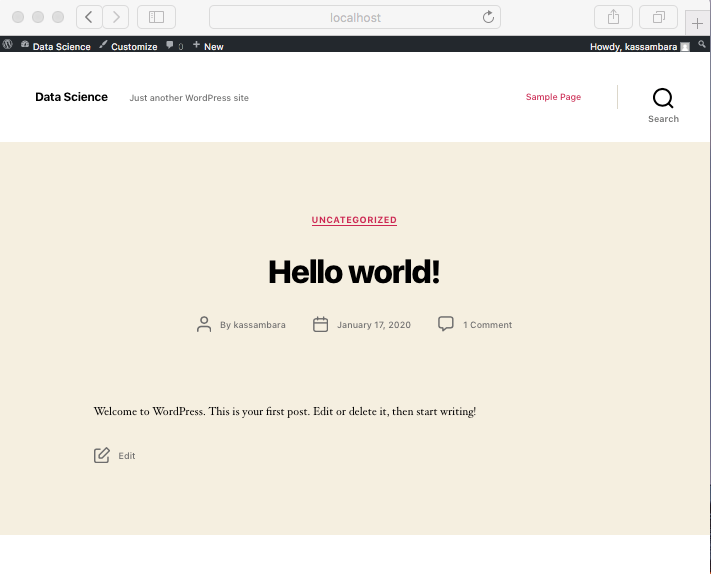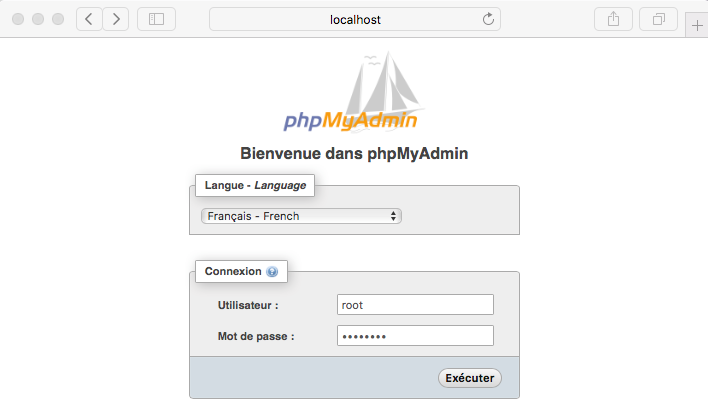This article shows an example of WordPress Docker setup files for local development on either Windows, MAC or Ubuntu.
The installation tool kit and setup files include:
- WordPress files
- MariaDB/MySQL used for WordPress database
- phpMyAdmin interface to connect to your MySQL database
- WP-Cli: WordPress Command Line Interface
- Makefile directives for automatization.
You will learn:
- WordPress Docker directory structure
- Docker-compose and WP-Cli configuration files
- Installing WordPress using docker-compose
Contents:
Step 1. Download a WordPress Docker setup template
Download a template from Github at: kassambara/wordpress-docker-compose
git clone https://github.com/kassambara/wordpress-docker-compose
cd wordpress-docker-composeProject directory structure:
files/wordpress-docker-compose
├── LICENSE
├── Makefile
├── README.Rmd
├── README.md
├── config
│ └── php.conf.ini
├── docker-compose-onlinehost.yml
├── docker-compose.yml
├── mysql
├── wordpress
├── wp-auto-config.yml
└── wpcli
├── Dockerfile
├── Makefile
└── entrypoint.shEssential folders:
- mysql: MySQL database files for MariaDB
- wordpress: WordPress web files
- wpcli contains a Dockerfile example to build WordPress CLI.
Essential files:
- .env file: contain the environment variables required for the wordpress installation
- docker-compose.yml: WordPress docker compose application services
- Makefile: Set of simple bash command lines to build, install and configure WordPress, as well as, to start and stop the docker containers.
Step 2. Inspect the content of the configuration files
We’ll inspect the following configuration files:
./docker-compose.yml: Defines docker services for running wordpress./wplci/Dockerfileand./wpcli/Makefile: Provides command lines options to manipulate wordpress database./Makefile: Providesmakecommands to start, install and autoinstall wordpress.
docker-compose configuration file
Inspect the content of the docker-compose.yml file, which defines 4 services:
- WordPress/PHP
- MySQL database
- phpMyAdmin interface to the database
- wpcli: WordPress command line interface
- healthcheck, which check whether services (MySQL, wordpress) are ready
version: '3.6'
services:
wordpress:
image: wordpress:${WORDPRESS_VERSION:-latest}
container_name: ${COMPOSE_PROJECT_NAME:-wordpress}
volumes:
- ./config/php.conf.ini:/usr/local/etc/php/conf.d/php.ini
- ${WORDPRESS_DATA_DIR:-./wordpress}:/var/www/html
environment:
- WORDPRESS_DB_NAME=${COMPOSE_PROJECT_NAME:-wordpress}
- WORDPRESS_TABLE_PREFIX=${WORDPRESS_TABLE_PREFIX:-wp_}
- WORDPRESS_DB_HOST=${WORDPRESS_DB_HOST:-mysql}
- WORDPRESS_DB_USER=${DATABASE_USER:-root}
- WORDPRESS_DB_PASSWORD=${DATABASE_PASSWORD:-password}
depends_on:
- mysql
- phpmyadmin
restart: always
ports:
- 80:80
mysql:
image: mariadb:${MARIADB_VERSION:-latest}
container_name: ${COMPOSE_PROJECT_NAME}_mysql
volumes:
- ./mysql:/var/lib/mysql
environment:
- MYSQL_ROOT_PASSWORD=${DATABASE_PASSWORD:-password}
- MYSQL_USER=${DATABASE_USER:-root}
- MYSQL_PASSWORD=${DATABASE_PASSWORD:-password}
- MYSQL_DATABASE=${COMPOSE_PROJECT_NAME:-wordpress}
restart: always
phpmyadmin:
depends_on:
- mysql
image: phpmyadmin/phpmyadmin:${PHPMYADMIN_VERSION:-latest}
container_name: ${COMPOSE_PROJECT_NAME}_phpmyadmin
restart: always
ports:
- ${PHPMYADMIN_PORT}:80
environment:
PMA_HOST: mysql
MYSQL_ROOT_PASSWORD: ${MYSQL_ROOT_PASSWORD:-password}
# Command line interface to wordpress
wpcli:
build: ./wpcli/
image: wpcli
container_name: ${COMPOSE_PROJECT_NAME}_wpcli
volumes:
- ${WORDPRESS_DATA_DIR:-./wordpress}:/var/www/html
working_dir: /var/www/html
# Check availability of essential services
healthcheck:
image: wpcli
build: ./wpcli/
container_name: ${COMPOSE_PROJECT_NAME}_healthcheck
command: sh -c "/wait"
environment:
- WAIT_HOSTS=mysql:3306, wordpress:80
- WAIT_BEFORE_HOSTS=${WAIT_BEFORE_HOSTS:-30}
- WAIT_AFTER_HOSTS=${WAIT_AFTER_HOSTS:-15}
- WAIT_HOSTS_TIMEOUT=${WAIT_HOSTS_TIMEOUT:-300}
- WAIT_SLEEP_INTERVAL=${WAIT_SLEEP_INTERVAL:-30}
- WAIT_HOST_CONNECT_TIMEOUT=${WAIT_HOST_CONNECT_TIMEOUT:-30}Note that, under the wordpress application, we map the ./config/php.conf.ini into the container so that the PHP picks up our additional configuration settings specified below. This makes it possible to increase the upload limit.
Contents of: ./config/php.conf.ini
file_uploads = On
memory_limit = 512M
upload_max_filesize = 64M
post_max_size = 64M
max_execution_time = 600
Note also that, the provided docker-compose.yml file includes the phpMyAdmin application. If you want to use the admirer interface for your database, then add the following directives in your docker-compose.yml file in lieu of the phpMyAdmin directives.
adminer:
image: adminer
restart: always
links:
- mysql
ports:
- 8080:8080WP Cli Dockerfile and configuration file
The WordPress cli is built from the following Dockerfile, which includes the docker-compose-wait tool. The wait tool makes it possible to wait for a container to be ready before running another container. This makes wp-cli wait for MySQL to be ready before manipulating the database.
WP Cli Dockerfile (path: ./wpcli/Dockerfile):
FROM wordpress:cli
# Install make tool
USER root
RUN apk add --no-cache make
# Make docker-compose wait for container dependencies be ready
# Add the wait script to the image
ENV WAIT_VERSION 2.7.2
ADD https://github.com/ufoscout/docker-compose-wait/releases/download/$WAIT_VERSION/wait /wait
RUN chmod +x /wait
# Add Makefile to scripts dir
ADD Makefile entrypoint.sh /scripts/
RUN chmod +x /scripts/entrypoint.sh
ENTRYPOINT [ "/scripts/entrypoint.sh" ]
USER 33:33
CMD ["wp", "shell"]This Dockerfile is based on wordpress:cli, installs the docker-compose-wait and has an entrypoint, which can either execute WP-cli or a Makefile.
Note that, the wordpress:latest and wpcli images both run with the user www-data, but the problem is that the individual www-data users have different user-id’s:
- user-id=33 in wordpress
- user-id=82 in wpcli
We have to make sure they both use the same user-id. This can be solved by having the wpcli run with the USER 33:33 in the Dockerfile.
The WP Cli tool automates the installation of WordPress using the following Makefile (path: ./wpcli/Makefile):
install: configure
configure:
@echo "⚙️ Configuring WordPress parameters..."
wp core install \
--url=${WORDPRESS_WEBSITE_URL_WITHOUT_HTTP} \
--title=$(WORDPRESS_WEBSITE_TITLE) \
--admin_user=${WORDPRESS_ADMIN_USER} \
--admin_password=${WORDPRESS_ADMIN_PASSWORD} \
--admin_email=${WORDPRESS_ADMIN_EMAIL}
wp option update siteurl ${WORDPRESS_WEBSITE_URL}
wp rewrite structure $(WORDPRESS_WEBSITE_POST_URL_STRUCTURE)Using this Makefile, the WP-Cli tool will configure:
- URL and title of website.
- URL structure.
Make commands for automatic WordPress setup
Path: ./Makefile
start:
docker-compose up -d --build
healthcheck:
docker-compose run --rm healthcheck
down:
docker-compose down
install: start healthcheck
configure:
docker-compose -f docker-compose.yml -f wp-auto-config.yml run --rm wp-auto-config
autoinstall: start
docker-compose -f docker-compose.yml -f wp-auto-config.yml run --rm wp-auto-config
clean: down
@echo "💥 Removing related folders/files..."
@rm -rf mysql/* wordpress/*
reset: cleanThanks to this Makefile, you will be able to automatically install and configure wordpress using make autoinstall.
Step 3. Edit the WordPress Docker setup environment variables
A .env file has been included to easily set docker-compose variables without having to modify the docker-compose.yml configuration file itself.
Default values have been provided as a mean of getting up and running quickly for testing purposes. It is up to the user to modify these to best suit their deployment preferences.
Open the .env file and update the contents if you want. For example, just change the project name and your password (for database and wordpress admin).
# Open the file
nano .envContents:
# 1/ Project name -------------------------------------------------
# Must be lower-case, no spaces and no invalid path chars.
# Will be used also as the WP database name
COMPOSE_PROJECT_NAME=wordpress
# 2/ Database user and password -----------------------------------------
# Set non-root database user if wanted (optional)
DATABASE_PASSWORD=password
DATABASE_USER=root
# 3/ For wordpress auto-install and auto-configuration -------------------
WORDPRESS_WEBSITE_TITLE="My Blog"
# URL
WORDPRESS_WEBSITE_URL="http://localhost"
WORDPRESS_WEBSITE_URL_WITHOUT_HTTP=localhost
WORDPRESS_WEBSITE_POST_URL_STRUCTURE="/blog/%postname%/"
# Website admin identification. Specify a strong password
WORDPRESS_ADMIN_USER="wordpress"
WORDPRESS_ADMIN_PASSWORD="wordpress"
WORDPRESS_ADMIN_EMAIL="your-email@example.com"
# 4/ Software versions -----------------------------------------------
WORDPRESS_VERSION=latest
MARIADB_VERSION=latest
PHPMYADMIN_VERSION=latest
# 5/ Ports: Can be changed -------------------------------------------
PHPMYADMIN_PORT=8080
# 6/ Volumes on host --------------------------------------------------
WORDPRESS_DATA_DIR=./wordpress
# 7/ Healthcheck availability of host services (mysql and woordpress server)
# Waiting time in second
WAIT_BEFORE_HOSTS=5
WAIT_AFTER_HOSTS=5
WAIT_HOSTS_TIMEOUT=300
WAIT_SLEEP_INTERVAL=60
WAIT_HOST_CONNECT_TIMEOUT=5
# 8/ Used only in online deployement --------------------------------------
WORDPRESS_WEBSITE_URL_WITHOUT_WWW=example.com
PHPMYADMIN_WEBSITE_URL_WITHOUT_HTTP=sql.example.comStep 4. Install WordPress using docker compose
You can automatically deploy a local docker wordpress site in 5 minutes using the following commands. Two options are available: make command and docker-compose standard commands.
# Download a wordpress docker-compose example
git clone https://github.com/kassambara/wordpress-docker-compose
cd wordpress-docker-compose
# Use make command for automatic installation and
# configuration of wordpress
make autoinstall
# Or, use docker-compose standard commands
docker-compose up -d --build
docker-compose -f docker-compose.yml -f wp-auto-config.yml run --rm wp-auto-config- Visit your wordpress website at http://localhost. Default identification for admin (http://localhost/wp-login.php):
Username: wordpressandPassword: wordpress

- Visit your database via phpMyAdmin at http://localhost:8080
Username: rootandPassword: password

Step 5. Shutdown and cleanup
# Stop and remove containers
docker-compose down
# Build, and start the wordpress website
docker-compose up -d --build
# Reset everything
docker-compose down
rm -rf mysql/* wordpress/*
Note that, instead of using the above docker-compose commands, you can also use easily the following make shortcut command lines if you have Unix systems (MAC / Linux).
# Build, and start the wordpress website
make start
# Stop and remove wordpress docker containers
make down
# Reset everything
make resetSummary
This article describes the WordPress Docker setup and associated configuration files to install and run WordPress using docker-compose
Recommended for you
This section contains best data science and self-development resources to help you on your path.
Coursera - Online Courses and Specialization
Data science
- Course: Machine Learning: Master the Fundamentals by Stanford
- Specialization: Data Science by Johns Hopkins University
- Specialization: Python for Everybody by University of Michigan
- Courses: Build Skills for a Top Job in any Industry by Coursera
- Specialization: Master Machine Learning Fundamentals by University of Washington
- Specialization: Statistics with R by Duke University
- Specialization: Software Development in R by Johns Hopkins University
- Specialization: Genomic Data Science by Johns Hopkins University
Popular Courses Launched in 2020
- Google IT Automation with Python by Google
- AI for Medicine by deeplearning.ai
- Epidemiology in Public Health Practice by Johns Hopkins University
- AWS Fundamentals by Amazon Web Services
Trending Courses
- The Science of Well-Being by Yale University
- Google IT Support Professional by Google
- Python for Everybody by University of Michigan
- IBM Data Science Professional Certificate by IBM
- Business Foundations by University of Pennsylvania
- Introduction to Psychology by Yale University
- Excel Skills for Business by Macquarie University
- Psychological First Aid by Johns Hopkins University
- Graphic Design by Cal Arts
Amazon FBA
Amazing Selling Machine
Books - Data Science
Our Books
- Practical Guide to Cluster Analysis in R by A. Kassambara (Datanovia)
- Practical Guide To Principal Component Methods in R by A. Kassambara (Datanovia)
- Machine Learning Essentials: Practical Guide in R by A. Kassambara (Datanovia)
- R Graphics Essentials for Great Data Visualization by A. Kassambara (Datanovia)
- GGPlot2 Essentials for Great Data Visualization in R by A. Kassambara (Datanovia)
- Network Analysis and Visualization in R by A. Kassambara (Datanovia)
- Practical Statistics in R for Comparing Groups: Numerical Variables by A. Kassambara (Datanovia)
- Inter-Rater Reliability Essentials: Practical Guide in R by A. Kassambara (Datanovia)
Others
- R for Data Science: Import, Tidy, Transform, Visualize, and Model Data by Hadley Wickham & Garrett Grolemund
- Hands-On Machine Learning with Scikit-Learn, Keras, and TensorFlow: Concepts, Tools, and Techniques to Build Intelligent Systems by Aurelien Géron
- Practical Statistics for Data Scientists: 50 Essential Concepts by Peter Bruce & Andrew Bruce
- Hands-On Programming with R: Write Your Own Functions And Simulations by Garrett Grolemund & Hadley Wickham
- An Introduction to Statistical Learning: with Applications in R by Gareth James et al.
- Deep Learning with R by François Chollet & J.J. Allaire
- Deep Learning with Python by François Chollet
Version:
 Français
Français



Hey Guys. This was the best docker for wp development guide that I found so far. It teaches you everything and as a linux noobie It was sooooo good…
Keep Up The Good Work guys
Thank you much for the positive feedback, highly appreciated!
I just have love and gratitude for the amount of great practices and great tech put together to solve an old pain
Thank you for the positive feedback, highly appreciated
hi my friend. Thanks for this amazing post, my question: how should I use or run wp-cli?
I tried for example:
# wp –info
/bin/sh: 2: wp: not found
Please consider the following article for using wp-cli: https://www.datanovia.com/en/lessons/using-docker-wordpress-cli-to-manage-wordpress-websites/
Yes agreed this was so helpful and it actually works. Thanks so much. Now I just need to secure with ssl certs.
Good work. Kindly guide me on how I can add pre-installed plugins & theme – activate them after WordPress set-up. Plugins or themes from either Github or WordPress plugins source.
Hi, thanks, it is a very useful article. When new release is availabe for wordpress, and I would like to stop and relaunch it, the app will get the latest image from compose? It is not clear for me!